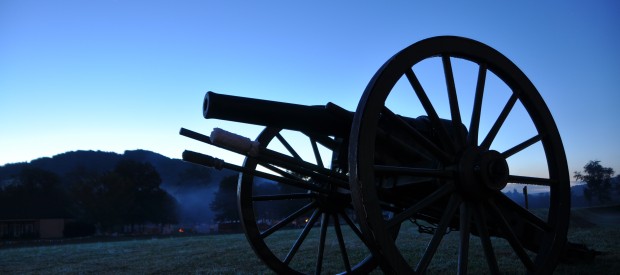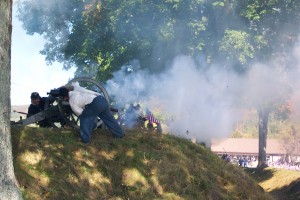
The Confederates under Gen. Sterling Price may have taken the fort, but Union efforts at Fort Davidson in the Battle of Pilot Knob were crucial to blunting the last Confederate offensive into Missouri. Fort Davidson State Historic Site preserves and interprets the running battle through the Arcadia Valley. The site’s open, grassy fields include the fort’s old earthworks, two Confederate burial trenches, and a visitor center with a narrated story of the battle. (in Pilot Knob on Hwy 221)
Every three years, 10,000+ visitors gather in September for the re-enactment of the Battle of Pilot Knob. In 2014, the 150th anniversary was celebrated by a week long series of concerts and lectures, culminating in the weekend battle re-enactment. Over 25,000 visitors attended this anniversary event. The next re-enactment will be in September, 2024.
Fort Davidson Historic Site winter hours – CLOSED on Mondays!

 The original engagement occurred on September 27, 1864, just outside of Pilot Knob in Iron County, Missouri. Although outnumbered by more than ten-to-one, the Union defenders managed to repulse repeated Confederate assaults on their works, and were able to slip away during the night by exploiting a gap in the Southern siege lines. The attacking Rebels took possession of the fort the next day, but Price’s profligate expenditure of men and ammunition ended his goal of seizing St. Louis for the Confederacy.
The original engagement occurred on September 27, 1864, just outside of Pilot Knob in Iron County, Missouri. Although outnumbered by more than ten-to-one, the Union defenders managed to repulse repeated Confederate assaults on their works, and were able to slip away during the night by exploiting a gap in the Southern siege lines. The attacking Rebels took possession of the fort the next day, but Price’s profligate expenditure of men and ammunition ended his goal of seizing St. Louis for the Confederacy.
Today, the battle area and a museum is operated by the Missouri State Parks system as “Fort Davidson State Historic Site”. The earthworks of the fort are still generally intact, surrounding the huge hole that was caused by the powder explosion. Following the battle, the Confederates retained the field and were therefore responsible for burying the dead. One of the rifle pits was accordingly selected for use as a mass grave. Although the exact number of Confederate casualties are unknown, park historians estimate that total Southern casualties were approximately 1,000. This compares to 200 Union casualties, 28 of whom were killed. The mass grave is now marked by a granite monument. The site is listed on the U.S. National Register of Historic Places.








